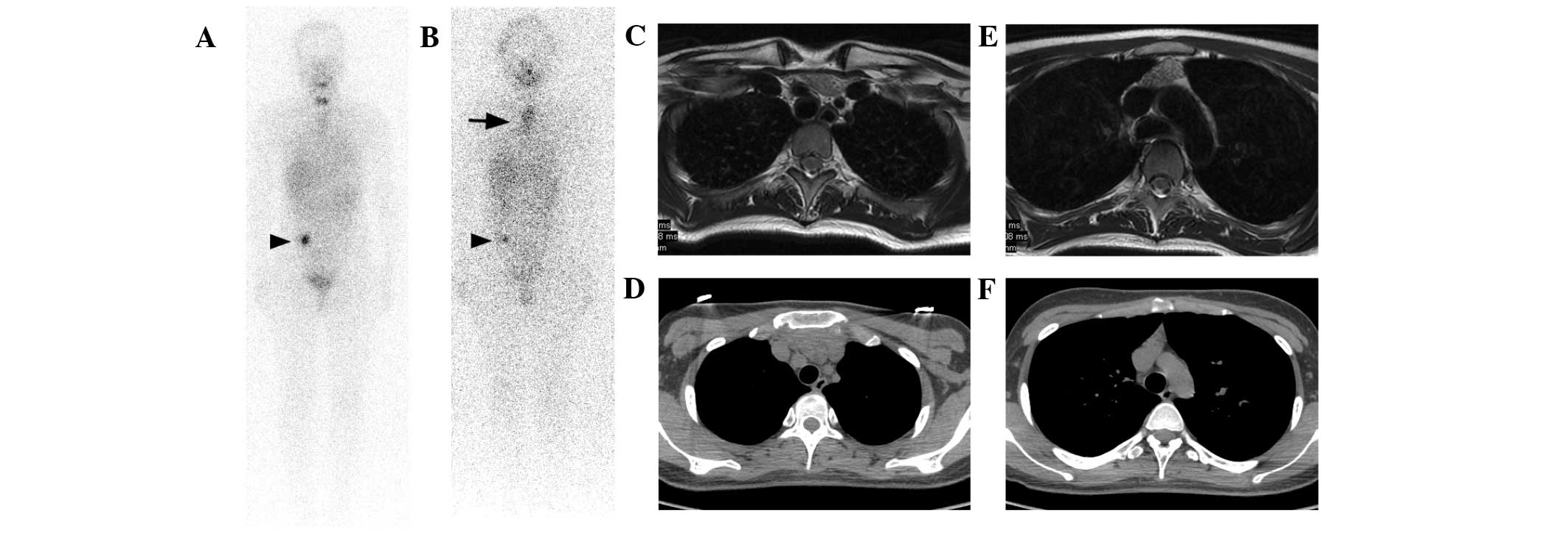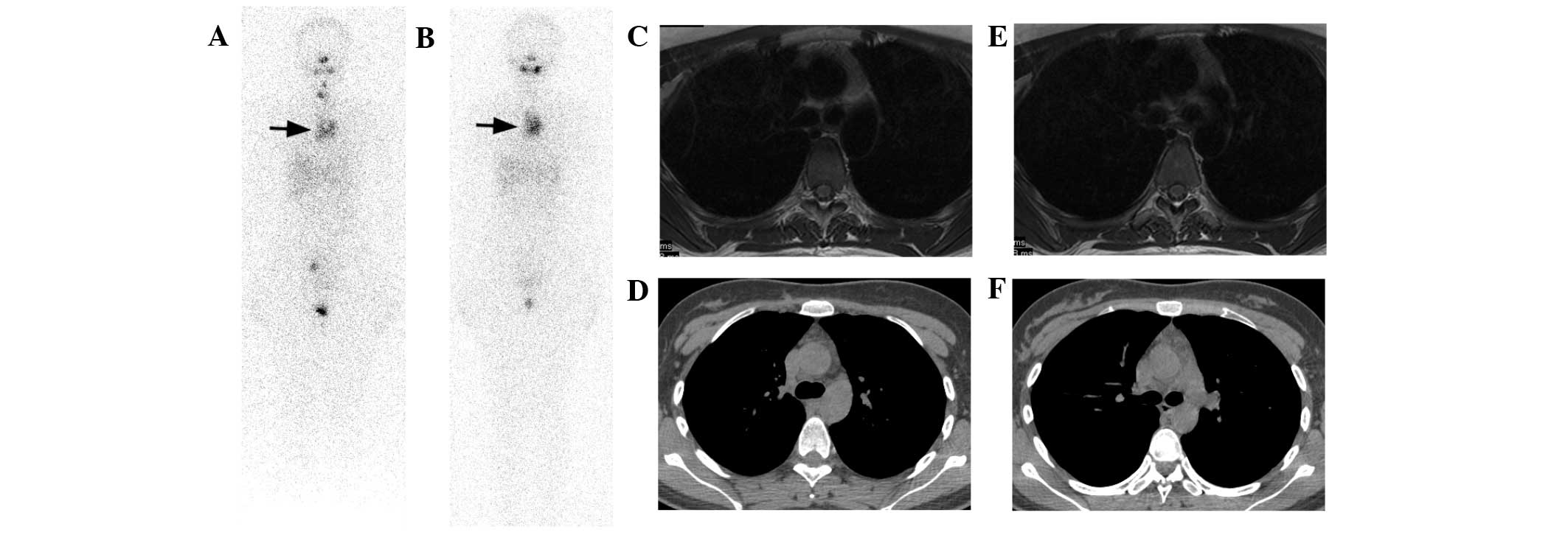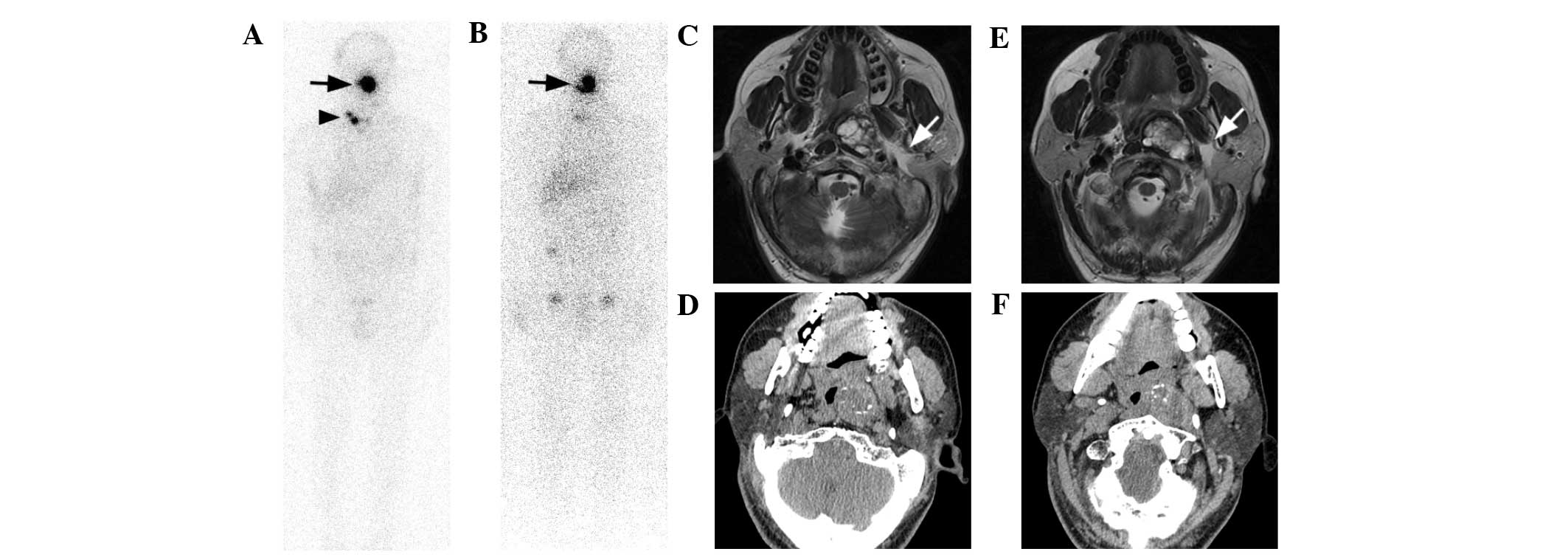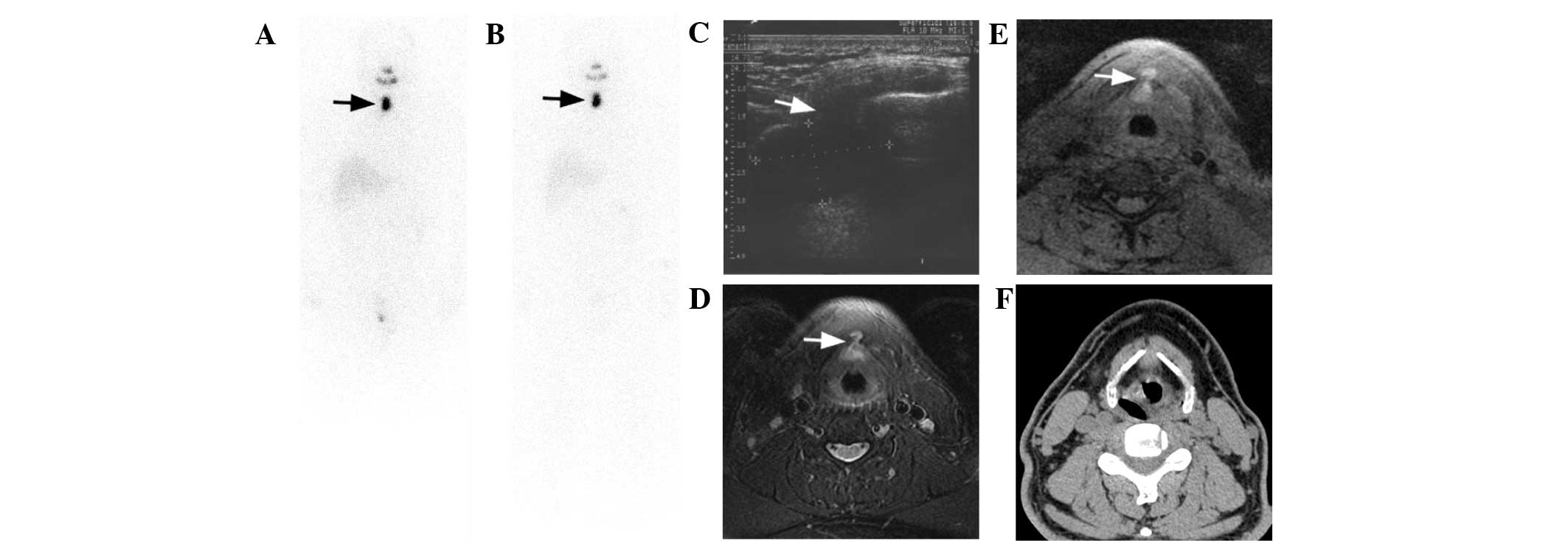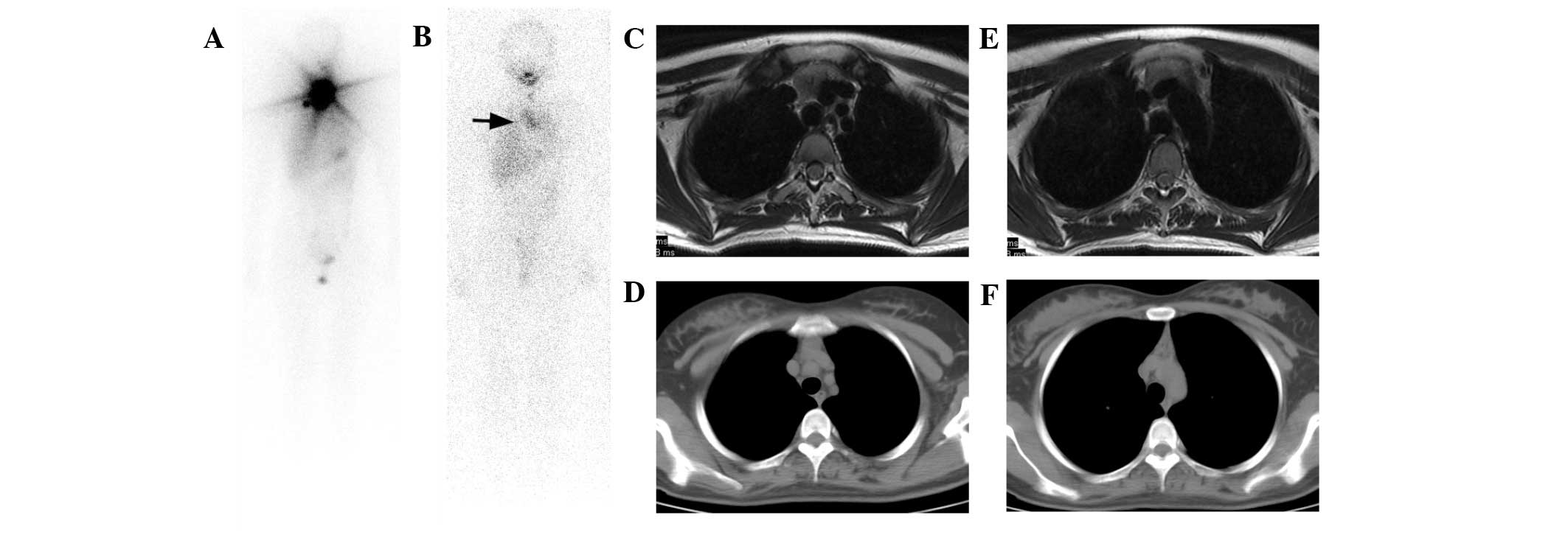|
1
|
Cooper DS, Doherty GM, Haugen BR, Kloos
RT, Lee SL, Mandel SJ, Mazzaferri EL, McIver B, Sherman SI and
Tuttle RM: American Thyroid Association Guidelines Taskforce:
Management guidelines for patients with thyroid nodules and
differentiated thyroid cancer. Thyroid. 16:109–142. 2006.
View Article : Google Scholar : PubMed/NCBI
|
|
2
|
American Thyroid Association (ATA)
Guidelines Taskforce on Thyroid Nodules and Differentiated Thyroid
Cancer. Cooper DS, Doherty GM, Haugen BR, Kloos RT, Lee SL, Mandel
SJ, Mazzaferri EL, McIver B, Pacini F, Schlumberger M, et al:
Revised American Thyroid Association management guidelines for
patients with thyroid nodules and differentiated thyroid cancer.
Thyroid. 19:1167–1214. 2009. View Article : Google Scholar : PubMed/NCBI
|
|
3
|
Carlisle MR, Lu C and McDougall IR: The
interpretation of 131I scans in the evaluation of
thyroid cancer, with an emphasis on false positive findings. Nucl
Med Commun. 24:715–735. 2003. View Article : Google Scholar : PubMed/NCBI
|
|
4
|
van Sorge-van Boxtel RA, van Eck-Smit BL
and Goslings BM: Comparison of serum thyroglobulin, 131I
and 201Tl scintigraphy in the postoperative follow-up of
differentiated thyroid cancer. Nucl Med Commun. 14:365–372. 1993.
View Article : Google Scholar : PubMed/NCBI
|
|
5
|
Lubin E, Mechlis-Frish S, Zatz S, Shimoni
A, Segal K, Avraham A, Levy R and Feinmesser R: Serum thyroglobulin
and iodine-131 whole-body scan in the diagnosis and assessment of
treatment for metastatic differentiated thyroid carcinoma. J Nucl
Med. 35:257–262. 1994.PubMed/NCBI
|
|
6
|
McDougall IR: Whole-body scintigraphy with
radioiodine-131. A comprehensive list of false-positives with some
examples. Clin Nucl Med. 20:869–875. 1995. View Article : Google Scholar : PubMed/NCBI
|
|
7
|
Sawka AM, Thabane L, Parlea L,
Ibrahim-Zada I, Tsang RW, Brierley JD, Straus S, Ezzat S and
Goldstein DP: Second primary malignancy risk after radioactive
iodine treatment for thyroid cancer: A systematic review and
meta-analysis. Thyroid. 19:451–457. 2009. View Article : Google Scholar : PubMed/NCBI
|
|
8
|
Rubino C, de Vathaire F, Dottorini ME,
Hall P, Schvartz C, Couette JE, Dondon MG, Abbas MT, Langlois C and
Schlumberger M: Second primary malignancies in thyroid cancer
patients. Br J Cancer. 89:1638–1644. 2003. View Article : Google Scholar : PubMed/NCBI
|
|
9
|
Shapiro B, Rufini V, Jarwan A, Geatti O,
Kearfott KJ, Fig LM, Kirkwood ID and Gross MD: Artifacts,
anatomical and physiological variants, and unrelated diseases that
might cause false-positive whole-body 131-I scans in patients with
thyroid cancer. Semin Nucl Med. 30:115–132. 2000. View Article : Google Scholar : PubMed/NCBI
|
|
10
|
Sutter CW, Masilungan BG and Stadalnik RC:
False-positive results of I-131 whole-body scans in patients with
thyroid cancer. Semin Nucl Med. 25:279–282. 1995. View Article : Google Scholar : PubMed/NCBI
|
|
11
|
Greenler DP and Klein HA: The scope of
false-positive iodine-131 images for thyroid carcinoma. Clin Nucl
Med. 14:111–117. 1989. View Article : Google Scholar : PubMed/NCBI
|
|
12
|
Bakheet SM and Hammami MM: False-positive
radioiodine whole-body scan in thyroid cancer patients due to
unrelated pathology. Clin Nucl Med. 19:325–329. 1994. View Article : Google Scholar : PubMed/NCBI
|
|
13
|
Mitchell G, Pratt BE, Vini L, McCready VR
and Harmer CL: False positive 131I whole body scans in thyroid
cancer. Br J Radiol. 73:627–635. 2000. View Article : Google Scholar : PubMed/NCBI
|
|
14
|
Niendorf ER, Parker JA, Yechoor V, Garber
JR and Boiselle PM: Thymic hyperplasia in thyroid cancer patients.
J Thorac Imaging. 20:1–4. 2005. View Article : Google Scholar : PubMed/NCBI
|
|
15
|
Davidson J and McDougall IR: How
frequently is the thymus seen on whole-body iodine-131 diagnostic
and post-treatment scans? Eur J Nucl Med. 27:425–430. 2000.
View Article : Google Scholar : PubMed/NCBI
|
|
16
|
Spitzweg C, Joba W, Eisenmenger W and
Heufelder AE: Analysis of human sodium iodide symporter gene
expression in extrathyroidal tissues and cloning of its
complementary deoxyribonucleic acids from salivary gland, mammary
gland and gastric mucosa. J Clin Endocrinol Metab. 83:1746–1751.
1998. View Article : Google Scholar : PubMed/NCBI
|
|
17
|
Meller J and Becker W: The human
sodium-iodine symporter (NIS) as a key for specific thymic
iodine-131 uptake. Eur J Nucl Med. 27:473–474. 2000. View Article : Google Scholar : PubMed/NCBI
|
|
18
|
Michigishi T, Mizukami Y, Shuke N,
Yokoyama K, Noguchi M, Watanabe Y, Matsui O, Aburano T, Tonami N
and Hisada K: Visualization of the thymus with therapeutic doses of
radioiodine in patients with thyroid cancer. Eur J Nucl Med.
20:75–79. 1993. View Article : Google Scholar : PubMed/NCBI
|
|
19
|
Bozza F, Vigili MG, Ruscito P, Marzetti A
and Marzetti F: Surgical management of parapharyngeal space
tumours: Results of 10-year follow-up. Acta Otorhinolaryngol Ital.
29:10–15. 2009.PubMed/NCBI
|
|
20
|
Dimitrijevic MV, Jesic SD, Mikic AA,
Arsovic NA and Tomanovic NR: Parapharyngeal space tumors: 61 case
reviews. Int J Oral Maxillofac Surg. 39:983–989. 2010. View Article : Google Scholar : PubMed/NCBI
|
|
21
|
Sergi B, Limongelli A, Scarano E, Fetoni
AR and Paludetti G: Giant deep lobe parotid gland pleomorphic
adenoma involving the parapharyngeal space. Report of three cases
and review of the diagnostic and therapeutic approaches. Acta
Otorhinolaryngol Ital. 28:261–265. 2008.PubMed/NCBI
|
|
22
|
Papadogeorgakis N, Petsinis V, Goutzanis
L, Kostakis G and Alexandridis C: Parapharyngeal space tumors:
Surgical approaches in a series of 13 cases. Int J Oral Maxillofac
Surg. 39:243–250. 2010. View Article : Google Scholar : PubMed/NCBI
|
|
23
|
Shi H, Wang P, Wang S and Yu Q:
Pleomorphic adenoma with extensive ossified and calcified
degeneration: Unusual CT findings in one case. AJNR Am J
Neuroradiol. 29:737–738. 2008. View Article : Google Scholar : PubMed/NCBI
|
|
24
|
Basaria S, Westra WH and Cooper DS:
Ectopic lingual thyroid masquerading as thyroid cancer metastases.
J Clin Endocrinol Metab. 86:392–395. 2001. View Article : Google Scholar : PubMed/NCBI
|
|
25
|
Zanotti-Fregonara P, Hindié E, Keller I,
Calzada-Nocaudie M and Devaux JY: Scintigraphic visualization of
glossal thyroid tissue during the follow-up of thyroid cancer
patients. Clin Nucl Med. 32:911–914. 2007. View Article : Google Scholar : PubMed/NCBI
|
|
26
|
Li D, Meng Z, Zhang G, Yu T, Tan J and
Dong F: Visualization of thyroglossal duct cyst in differentiated
thyroid cancer patient. Clin Nucl Med. 35:499–504. 2010. View Article : Google Scholar : PubMed/NCBI
|
|
27
|
Kaplan SL, Mandel SJ, Muller R, Baloch ZW,
Thaler ER and Loevner LA: The role of MR imaging in detecting nodal
disease in thyroidectomy patients with rising thyroglobulin levels.
AJNR Am J Neuroradiol. 30:608–612. 2009. View Article : Google Scholar : PubMed/NCBI
|
|
28
|
Gross ND, Weissman JL, Talbot JM, Andersen
PE, Wax MK and Cohen JI: MRI detection of cervical metastasis from
differentiated thyroid carcinoma. Laryngoscope. 111:1905–1909.
2001. View Article : Google Scholar : PubMed/NCBI
|
|
29
|
Toubert ME, Cyna-Gorse F, Zagdanski AM,
Noel-Wekstein S, Cattan P, Billotey C, Sarfati E and Rain JD:
Cervicomediastinal magnetic resonance imaging in persistent or
recurrent papillary thyroid carcinoma: Clinical use and limits.
Thyroid. 9:e-5971999. View Article : Google Scholar
|















